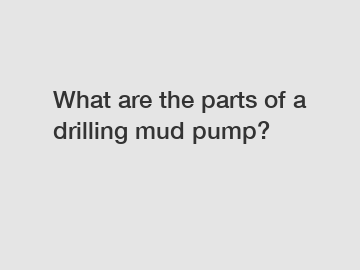Mar. 26, 2024
Mechanical Parts & Fabrication Services
Drilling mud pumps are essential equipment used in the oil and gas industry to facilitate the drilling process. These powerful pumps play a crucial role in circulating drilling fluid, also known as mud, downhole to cool the drill bit, remove cuttings, and maintain wellbore stability. Understanding the different parts of a drilling mud pump is key to ensuring its optimal performance and longevity. In this article, we will explore the various components that make up a drilling mud pump and their functions.
###Power End Components.
The power end of a drilling mud pump contains the components responsible for converting mechanical energy into hydraulic energy to drive the fluid through the system. The primary parts of the power end include:

1. Frame: The frame provides the structure and support for the entire pump assembly. It must be sturdy and durable to withstand the high pressures and forces generated during operation.
2. Crankshaft: The crankshaft is connected to the power source, such as an electric motor or diesel engine, and converts the rotational motion into reciprocating motion. This movement drives the pistons to create the pumping action.
3. Connecting Rods: Connecting rods transfer the motion from the crankshaft to the pistons, allowing them to move up and down within the fluid end of the pump.
###Fluid End Components.
The fluid end of a drilling mud pump contains the components that come into direct contact with the drilling fluid. These parts must be able to withstand corrosion and abrasion while maintaining a tight seal to prevent leaks. The key components of the fluid end include:
1. Pistons: Pistons are responsible for creating the pumping action by moving back and forth within the pump cylinder. They are typically made of durable materials such as hardened steel or ceramic to withstand the harsh operating conditions.
2. Liners: Liners provide a smooth surface for the pistons to move against and help to maintain the integrity of the pump cylinder. They are designed to be easily replaceable to minimize downtime and maintenance costs.
3. Valves: Valves control the flow of drilling fluid in and out of the pump cylinder. There are typically two types of valves used in mud pumps: suction valves and discharge valves. These valves must be able to handle high pressures and abrasive fluids without leaking.
4. Discharge Manifold: The discharge manifold collects the pressurized drilling fluid from the pump cylinders and directs it to the drilling rig's circulation system. It is crucial for maintaining the desired flow rate and pressure during drilling operations.
###Conclusion.
In conclusion, the parts of a drilling mud pump work together to efficiently circulate drilling fluid and facilitate the drilling process. Proper maintenance and inspection of these components are essential to ensure the pump's reliability and longevity. By understanding the functions of each part, operators can troubleshoot issues quickly and prevent costly downtime. If you have any questions about drilling mud pumps or would like assistance with your pump system, don't hesitate to contact us.
Contact us for more information on drilling mud pumps and how to ensure their optimal performance and reliability.
Contact us to discuss your requirements of steel k55, solids control jet mud mixing pump for sale, mud drilling agitator. Our experienced sales team can help you identify the options that best suit your needs.
Previous: When were drilling rigs invented?
Next: Is Fiber Reinforced Polypropylene the Future of Packaging?
If you are interested in sending in a Guest Blogger Submission,welcome to write for us!
All Comments ( 0 )